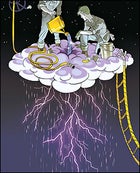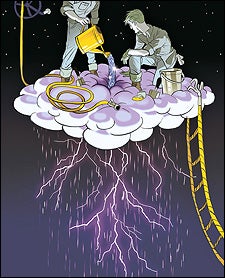PICTURE A FOREST OF ARTIFICIAL TREES that soak up carbon dioxide at a thousand times the rate of real plants. Imagine an orbiting shield spanning a million square miles, shading the earth from the sun, or a man-made volcano that spews great clouds of sulfur dioxide to deflect sunlight and cool the atmosphere.
code green

These ideas are controversial, expensive, and for the most part unproven, but don’t laugh them off┬Śthey’re inevitably going to become part of the debate about our future. They’re hot topics among researchers in the growing field of geoengineering, a term that refers to using grand-scale technologies to manipulate the earth’s atmosphere in ways that could combat global warming. Plenty of environmentalists, fearing a range of ecological side effects, are waving red flags, and many atmospheric scientists still call climate-altering schemes unrealistic. But these ideas are quickly gaining support┬Śnot just from late-night radio hosts but from mainstream scientists concerned that greenhouse-gas reductions aren’t happening fast enough and won’t, by themselves, be enough to stabilize the climate.
James Hansen, director of NASA’s Goddard Institute for Space Studies and the man who famously sounded the climate-change alarm in 1988, made the case for geoengineering last February at the National Press Club, saying it’s “probably needed” as an insurance policy in case of irreversible global warming. Paul Crutzen, the Danish chemist who won a 1995 Nobel Prize for his work connecting pollution and damage to the ozone layer, argued in the August 2006 issue of the journal Climatic Change that a threat as imminent as global warming requires a viable “escape route.”
“There’s a growing sense of desperation among scientists,” says Marty Hoffert, a New York University physics professor and geoengineering proponent. “It comes from the immense gap between what they think should be done to address climate change and what governments are actually doing.”
The idea isn’t to stop pushing for tough federal emissions standards or slow the search for cleaner, renewable sources of energy. It’s to add geoengineering solutions to our mix of options.
That doesn’t sound so crazy in light of recent reports from the Intergovernmental Panel on Climate Change, a UN-sponsored consortium of more than 2,500 international scientists. A February IPCC report stated that humans are largely to blame for the warming trends seen over the past 50 years. “The effects of climate change are happening faster than we thought even five years ago,” says Kristie Ebi, a public health consultant and contributing author for the IPCC. In May, the panel concluded that the most catastrophic effects of climate change may be unavoidable if global emissions don’t begin to decline within a decade┬Śa sobering reality check, especially as China and India continue to industrialize.
“We’re putting all our energy into Plan A┬Śto reduce emissions enough to prevent heating┬Śbut the situation may be so dire that we need a Plan B,” says David Doniger, policy director of the Natural Resources Defense Council’s Climate Center.
Plan B might include outlandish-sounding ideas like the simulated volcano concept that Crutzen has proposed. In 1991, when Mount Pinatubo blew its top in the Philippines, 20 million tons of sulfur dioxide particles clouded the atmosphere, slightly reducing temperatures around the world. Crutzen suggests releasing clouds of sulfur dioxide from high-altitude balloons, or blasting them skyward in artillery shells. The particles would float in the stratosphere for roughly two years before dispersing, and could lower sunlight’s intensity by 2 percent throughout the world.
There are potential downsides, of course. The atmospheric injection might make our days hazier. Sulfur dioxide could produce acid rain if large quantities were to drift into the lower atmosphere. The project is iffy at best and could cost up to $50 billion. Still, the National Center for Atmospheric Research is working with Crutzen to test this idea using computer simulations.
Columbia University geophysicist Klaus Lackner, meanwhile, envisions a “forest” of structures that look more like billboards than trees. The 100-by-200-foot steel rectangles would have surfaces that soak up carbon dioxide┬Śsimulating photosynthesis┬Śthen “exhale” the CO2 in a concentrated stream that would be stored in underground chambers. One “tree” could, over one year, vacuum up the annual emissions equivalent of 15,000 cars. Yet if the energy required to operate the trees comes from fossil fuels, say critics, the carbon savings would be minimal.
Over at NASA, researchers are looking at solutions like “seeding” clouds with seawater, to make them more reflective, and creating a giant sun shield in space. The 60,000-mile-long structure would be launched from the earth in billions of pieces; once in place, it could block 2 percent of incoming sunlight. The estimated cost for the first 50 years: more than $3 trillion. It’s a long shot, but NASA has awarded a $75,000 grant to University of Arizona astronomer Roger Angel, who’s developing the sun-shield blueprint.
Even private investors are getting in the game┬Śspurred on, perhaps, by this year’s offer from Virgin mega-mogul Richard Branson to award $25 million to the first person who comes up with a viable CO2-busting scheme. In tests begun early this summer, a Silicon Valley startup called Planktos planned to dump 50 to 70 tons of powdered iron, an essential nutrient for the growth of plankton blooms, into the South Pacific. Theoretically, the resulting bloom will soak up 20 million to 30 million tons of CO2 before it dies and sinks to the deep ocean. Skeptics say the plants may rerelease most of that carbon dioxide when they decompose and are eaten by other creatures, minimizing the carbon offset while having unknown effects on the ocean’s health.
It’s easy to understand why few environmental leaders are cheering all this research. It does, after all, involve messing with nature on a scale that makes the Hoover Dam look like a Tinkertoy. Every plan has the potential to wreak eco-havoc, even in best-case scenarios.
“We have to be sure we don’t try to solve one ecological disaster by creating another one,” says John Passacantando, executive director of Greenpeace USA.
Another concern is that geoengineering debates could distract policymakers from the more immediate challenge of passing greenhouse-gas-reduction regulations.
“Why sit around figuring out how big the sponge should be when we haven’t even begun to contain the size of the mess,” says Dan Becker, director of the Sierra Club’s global-warming program. “It’s a waste of precious time and resources.”
Free-market supporters argue that technology may prove more efficient than regulatory measures. “I’m not convinced that some of the behavior-based solutions pass the cost-benefit test,” says Jonah Goldberg, a National Review contributing editor. “Historically, when humans have met with challenges┬Śsome caused by them, some by other things┬Śingenuity has saved the day.”
“Playing God is dangerous,” counters Myron Ebell, the controversial director of energy and global-warming policy at the Washington, D.C.┬ľbased Competitive Enterprise Institute. “We don’t know what the ideal climate is. Cooling things down too much could be more problematic than warming.”
Ultimately, most everyone agrees, we need multiple strategies to deal with the climate crisis: emissions caps, alternative-energy research, better methods for capturing and storing carbon dioxide, and, yes, a contingency plan in the event that we face otherwise irreversible warming.
Contemplating far-out geoengineering schemes is certainly chilling. But we’ve already spent more than a century playing this game. What is global warming, after all, but an inadvertent experiment in altering the climate?


